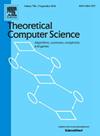Compatibility of convergence algorithms for autonomous mobile robots
IF 0.9
4区 计算机科学
Q3 COMPUTER SCIENCE, THEORY & METHODS
引用次数: 0
Abstract
We investigate a swarm of anonymous oblivious mobile robots under the semi-synchronous () scheduler. Each robot has a function called target function to decide the destination from the robots' positions, and operates in Look-Compute-Move cycles, i.e., identifies the robots' positions, computes the destination by the target function, and then moves there. Robots may have different target functions. Let Φ and Π be a set of target functions and a problem, respectively. If the robots whose target functions are chosen from Φ always solve Π, we say that Φ is compatible with respect to Π. If Φ is compatible with respect to Π, every target function is an algorithm for Π (in the conventional sense). Note that even if both ϕ and are algorithms for Π, may not be compatible with respect to Π.
From the view point of compatibility, we investigate the convergence, the fault tolerant ()-convergence (FC(f)), the fault tolerant ()-convergence to f points (FC(f)-PO), the fault tolerant ()-convergence to a convex f-gon (FC(f)-CP), and the gathering problems, assuming crash failures. As a result, we see that these problems are classified into three groups: The convergence, the FC(1), the FC(1)-PO, and the FC(f)-CP compose the first group: Every set of target functions which always shrink the convex hull of a configuration is compatible. The second group is composed of the gathering and the FC(f)-PO for : No set of target functions which always shrink the convex hull of a configuration is compatible. The third group, the FC(f) for , is placed in between. Thus, the FC(1) and the FC(2), the FC(1)-PO and the FC(2)-PO, and the FC(2) and the FC(2)-PO are respectively in different groups, despite that the FC(1) and the FC(1)-PO are in the first group.
自主移动机器人收敛算法的兼容性
研究了半同步调度下的一群匿名遗忘移动机器人。每个机器人都有一个叫做目标函数的函数,从机器人的位置决定目的地,并以Look-Compute-Move的循环方式运行,即识别机器人的位置,通过目标函数计算目的地,然后移动到那里。机器人可能有不同的目标功能。设Φ和Π分别是一组目标函数和一个问题。如果目标函数从Φ中选择的机器人总是求解Π,我们说Φ相对于Π是兼容的。如果Φ与Π兼容,则每个目标函数Φ∈Φ都是Π(传统意义上)的算法。请注意,即使ϕ和ϕ ‘都是Π的算法,{ϕ,ϕ ’}也可能与Π不兼容。从兼容性的角度,我们研究了收敛性、容错性(n,f)收敛性(FC(f))、容错性(n,f)收敛于f点(FC(f)-PO)、容错性(n,f)收敛于凸f-gon (FC(f)-CP)以及假设崩溃失败的集合问题。结果表明,这些问题可分为三类:收敛性问题、FC(1)问题、FC(1)-PO问题和FC(f)-CP问题构成第一类:总是收缩构型凸包的目标函数集是相容的。第二组由集合和f≥2时的FC(f)-PO组成:没有一组总是收缩一个构形的凸包的目标函数是相容的。第三组为f≥2时的FC(f),位于两者之间。因此,FC(1)和FC(2)、FC(1)-PO和FC(2)-PO、FC(2)和FC(2)-PO分别属于不同的组,尽管FC(1)和FC(1)-PO属于第一组。
本文章由计算机程序翻译,如有差异,请以英文原文为准。
求助全文
约1分钟内获得全文
求助全文
来源期刊

Theoretical Computer Science
工程技术-计算机:理论方法
CiteScore
2.60
自引率
18.20%
发文量
471
审稿时长
12.6 months
期刊介绍:
Theoretical Computer Science is mathematical and abstract in spirit, but it derives its motivation from practical and everyday computation. Its aim is to understand the nature of computation and, as a consequence of this understanding, provide more efficient methodologies. All papers introducing or studying mathematical, logic and formal concepts and methods are welcome, provided that their motivation is clearly drawn from the field of computing.
 求助内容:
求助内容: 应助结果提醒方式:
应助结果提醒方式:


